Application of a Digital Filter Method to Separate Baseflow in the Small Watershed of Pengchongjian in Southern China
Abstract
:1. Introduction
2. Materials and Methods
2.1. Study Area
2.2. Data Sources
2.3. Baseflow Separation by the BFI Method
2.4. Baseflow Separation by the Digital Filter Method
3. Results and Discussion
3.1. Baseflow Separation by the BFI Method
3.2. Baseflow Separation by the Digital Filter Method
3.3. Comparisons of the Baseflow Separation Results Between Different Methods
3.4. Intra- and Inter-Annual Variations in Baseflow
3.4.1. Monthly and Seasonal Variations in Baseflow
3.4.2. Inter-Annual Variation in Baseflow
4. Conclusions
- (1)
- β = 0.90 and T = 2 were the optimal parameters for baseflow separation by the digital filter method in the small watershed.
- (2)
- Average monthly baseflow increased initially but then decreased, having an uneven distribution in a given year, whereas average monthly BFI exhibited the opposite trend. On a seasonal scale, the baseflow peaked in the spring and lowest in the autumn, whereas the BFI was highest in the winter and lowest in the summer.
- (3)
- Annual baseflow and BFI underwent a decline from 1983 to 2014, equivalent to reduction rates of 2.30 mm/year and 0.0005/year, respectively. On the annual scale, the BFI was lower in a wet year and higher in a dry year compared with a normal year. The small watershed had an average BFI value for 1983–2014 of 0.22.
Author Contributions
Funding
Acknowledgments
Conflicts of Interest
References
- Tallaksen, L.M. A review of baseflow recession analysis. J. Hydrol. 1995, 165, 349–370. [Google Scholar] [CrossRef]
- Fan, Y.; Li, H.; Miguez-Macho, G. Global patterns of groundwater table depth. Science 2013, 339, 940–943. [Google Scholar] [CrossRef] [PubMed]
- Eckhardt, K. A comparison of baseflow indices, which were calculated with seven different baseflow separation methods. J. Hydrol. 2008, 352, 168–173. [Google Scholar] [CrossRef]
- Spongberg, M.E. Spectral analysis of base flow separation with digital filters. Water Resour. Res. 2000, 36, 745–752. [Google Scholar] [CrossRef]
- Arnold, J.G.; Allen, P.M. Automated methods for estimating baseflow and ground water recharge from streamflow records. J. Am. Water Resour. Assoc. 1999, 35, 411–424. [Google Scholar] [CrossRef]
- Mei, Y.; Anagnostou, E.N. A hydrograph separation method based on information from rainfall and runoff records. J. Hydrol. 2015, 523, 636–649. [Google Scholar] [CrossRef]
- Buffam, I.; Galloway, J.N.; Blum, L.K.; Karen, J.M. A stormflow/baseflow comparison of dissolved organic matter concentrations and bioavailability in an Appalachian stream. Biogeochemistry 2001, 53, 269–306. [Google Scholar] [CrossRef]
- Lohmann, D.; Raschke, E.; Nijssen, B.; Lettenmaier, D.P. Regional scale hydrology: I. Formulation of the VIC-2L model coupled to a routing model. Hydrol. Sci. J. 1998, 43, 131–141. [Google Scholar] [CrossRef]
- Singh, K.P. Some Factors affecting baseflow. Water Resour. Res. 1968, 4, 985–999. [Google Scholar] [CrossRef]
- Nutbrown, D.A.; Downing, R.A. Normal-mode analysis of the structure of baseflow-recession curves. J. Hydrol. 1976, 30, 327–340. [Google Scholar] [CrossRef]
- Nathan, R.J.; Mcmahon, T.A. Evaluation of automated techniques for baseflow and recession analyses. Water Resour. Res. 1990, 26, 1465–1473. [Google Scholar] [CrossRef]
- Chen, L.Q.; Liu, C.M.; Li, F.D. Reviews on baseflow researches. Prog. Geogr. 2006, 25, 1–15. (In Chinese) [Google Scholar]
- Zhang, X.; Srinivasan, R.; Arnold, J.; Izaurralde, R.C.; Bosch, D. Simultaneous calibration of surface flow and baseflow simulations: A revisit of the SWAT model calibration framework. Hydrol. Process. 2011, 25, 2313–2320. [Google Scholar] [CrossRef]
- Wittenberg, H. Baseflow recession and recharge as nonlinear storage processes. Hydrol. Process. 2015, 13, 715–726. [Google Scholar] [CrossRef]
- Mcguire, K.J.; Weiler, M.; Mcdonnell, J.J. Integrating tracer experiments with modeling to assess runoff processes and water transit times. Adv. Water Resour. 2007, 30, 824–837. [Google Scholar] [CrossRef]
- Joshi, SK.; Rai, S.P.; Sinha, R.; Gupta, S.; Densmore, A.L.; Rawat, Y.S.; Shekhar, S. Tracing groundwater recharge sources in the northwestern Indian alluvial aquifer using water isotopes (δ18O, δ2H and 3H). J. Hydrol. 2018, 559, 835–847. [Google Scholar] [CrossRef]
- Lyne, V.; Hollick, M. Stochastic time-variable rainfall-runoff modeling. In Institute Engineers Australia National Conference; Institute of Engineers: Canberra, Australia, 1979; Volume 10, pp. 89–93. [Google Scholar]
- Boughton, W.C. A hydrograph-based model for estimating the water yield of ungauged catchments. In Institute Engineers Australia National Conference; Institute of Engineers: Canberra, Australia, 1993; Volume 14, pp. 317–324. [Google Scholar]
- Chapman, T.G.; Maxwell, A.I. Baseflow separation-comparison of numerical methods with tracer experiments. In Institute Engineers Australia National Conference; Institute of Engineers: Canberra, Australia, 1996; Volume 5, pp. 539–545. [Google Scholar]
- Eckhardt, K. How to construct recursive digital filters for baseflow separation. Hydrol. Process. 2005, 19, 507–515. [Google Scholar] [CrossRef]
- Wels, C.; Cornett, R.J.; Lazerte, B.D. Hydrograph separation: A comparison of geochemical and isotopic tracers. J. Hydrol. 1991, 122, 253–274. [Google Scholar] [CrossRef]
- Aksoy, H.; Unal, N.E.; Pektas, A.O. Smoothed minima baseflow separation tool for perennial and intermittent streams. Hydrol. Process. 2008, 22, 4467–4476. [Google Scholar] [CrossRef]
- Aksoy, H.; Kurt, I.; Eris, E. Filtered smoothed minima baseflow separation method. J. Hydrol. 2009, 372, 94–101. [Google Scholar] [CrossRef]
- Sloto, R.A.; Crouse, M.Y. HYSEP: A Computer Program for Streamflow Hydrograph Separation and Analysis; US Geological Survey Water-Resources Investigations Report; US Department of the Interior: Washington, DC, USA, 1996; pp. 96–4040.
- Rutledge, A.T. Computer Program for Describing the Recession of Ground-Water Discharge and for Estimating Mean Ground-Water Recharge and Discharge from Streamflow Records; US Geological Survey Water-Resources Investigations Report; US Department of the Interior: Washington, DC, USA, 1993; pp. 98–4148.
- Arnold, J.G.; Allen, P.M.; Muttiah, R.S.; Bernhardt, G. Automated base flow separation recession analysis techniques. Groundwater 1995, 33, 1010–1018. [Google Scholar] [CrossRef]
- Ladson, A.; Brown, R.; Neal, B.; Nathan, R. A standard approach to baseflow separation using the Lyne and Hollick filter. Aust. J. Water Res. 2013, 17, 25–34. [Google Scholar] [CrossRef]
- Zhao, W.; Li, Z.L.; Wang, Y.H. Separation and characteristics of base flow in the upper reaches of Heihe River Basin. South North Water Transf. Water Sci. Tech. 2016, 14, 26–31. (In Chinese) [Google Scholar]
- Wang, J.Z.; Liu, Z.H.; Tashpolat, T.; Zhang, W.N. Variation of the baseflow and its causes of Hutubi River. J. Desert Res. 2017, 37, 793–801. (In Chinese) [Google Scholar]
- Santhi, C.; Allen, P.M.; Muttiah, R.S.; Arnold, J.G.; Tuppad, P. Regional estimation of base flow for the conterminous United States by hydrologic landscape regions. J. Hydrol. 2008, 351, 139–153. [Google Scholar] [CrossRef]
- Longobardi, A.; Villani, P. Baseflow index regionalization analysis in a mediterranean area and data scarcity context: Role of the catchment permeability index. J. Hydrol. 2008, 355, 63–75. [Google Scholar] [CrossRef]
- Koskelo, A.I.; Fisher, T.R.; Utz, R.M.; Jordan, T.E. A new precipitation-based method of baseflow separation and event identification for small watersheds (<50 km2). J. Hydrol. 2012, 450–451, 267–278. [Google Scholar] [CrossRef]
- Lin, X.Y.; Liao, Z.S.; Qian, Y.P.; Su, X.S. Baseflow separation for groundwater study in the Yellow River Basin, China. J. Jilin Univ. Earth Sci. Ed. 2009, 39, 959–967. (In Chinese) [Google Scholar]
- Li, R.; Zhang, S.F. Comparative study on two automatic baseflow separation methods in the arid and semi-arid regions. Prog. Geogr. 2017, 36, 864–872. (In Chinese) [Google Scholar]
- Yang, Q.N.; Gao, H.D.; Li, Z.B.; Wang, J. Effects of land use change in watershed on base flow in arid area. Res. Soil Water Conserv. 2018, 25, 317–322. (In Chinese) [Google Scholar]
- Dang, S.Z.; Wang, Z.G.; Liu, C.M. Baseflow separation and its characteristics in the upper reaches of the Heihe River Basin. Resour. Sci. 2011, 33, 2232–2237. (In Chinese) [Google Scholar]
- Quan, J.; Ma, J.L. Baseflow separation and its characteristics analysis in Shiyang River Basin. Water Resour. Power 2010, 28, 15–17. (In Chinese) [Google Scholar]
- Hu, S.; Yang, D.D.; Wu, J.; Gao, Y.; Qiu, H.J.; Cao, M.M.; Song, J.X.; Wan, H.L. Spatiotemporal variation characteristics of baseflow in the Bahe River Basin based in digital filter method and SWAT model. Sci. Geogr. Sin. 2017, 37, 455–463. (In Chinese) [Google Scholar]
- Lei, Y.N.; Zhang, X.P.; Zhang, J.J.; Liu, E.J. Change trends and driving factors of base flow in Kuye River Catchment. Acta Ecol. Sin. 2013, 33, 1559–1568. (In Chinese) [Google Scholar]
- Liu, J.; Li, W.; Wang, Y.; Li, Q.Y.; Li, Y.; Wu, J.S. Effects of landscape pattern on hydrological processes in the central subtropical hilly agricultural catchments. J. Ecol. Rural Environ. 2016, 32, 424–431. (In Chinese) [Google Scholar]
- Li, Y.; Li, Y.; Li, X. Response of hydrological processes to land cover and climate changes in Songhuaba watershed, Southwest China. Hydrol. Process. 2010, 23, 1179–1191. [Google Scholar]
- Huang, G.R.; Chen, Y.Q. Review of some problems about low runoff. Water Resour. Power 2005, 23, 61–64. (In Chinese) [Google Scholar]
- Liu, Y.W. The Research of Response Between Land Use/Cover Change and Baseflow in Meijiang Basin Based on GIS; Jiangxi Normal University: Nanchang, China, 2007. (In Chinese) [Google Scholar]
- Institute of Hydrology. Low Flow Studies; Institute of Hydrology: Wallingford, UK, 1980. [Google Scholar]
- Wahl, K.L.; Wahl, T.L. Effects of regional ground water declines on streamflows in the Oklahoma Panhandle. In Proceedings of the Symposium on Water-Use Data for Water Resources Management, Tucson, AZ, USA, 28–31 August 1988; pp. 239–249. [Google Scholar]
- Wahl, K.L.; Wahl, T.L. Determining the flow of comal springs at New Braunfels, Texas. In Proceedings of the Texas Water ’95, San Antonio, TX, USA, 16–17 August 1995; pp. 77–86. [Google Scholar]
- Lin, K.R.; Chen, X.H.; Jiang, T.; Li, C.Q. Application and study on base flow separation using digital filters. Water Power 2008, 34, 28–30. (In Chinese) [Google Scholar]
- Mau, D.P.; Winter, T.C. Estimating ground-water recharge from streamflow hydrographs for a small mountain watershed in a temperate humid climate, New Hampshire, USA. Groundwater 1997, 35, 291–304. [Google Scholar] [CrossRef]
- Cui, Y.J.; Liu, D.F.; Song, L.X.; Xiao, S.B.; Chen, L. Application of digital filtering theory in baseflow separation in Xiangxi River Watershed of three gorges reservoir area. J. Chin. Hydrol. 2011, 31, 18–23. (In Chinese) [Google Scholar]
- Zhang, W.N.; Liu, Z.H.; Wang, R.J.; Hu, M.; Yao, J.Q. Application of digital filtering theory in baseflow separation of Juntanghu River Watershed in northern slope of the Tianshan Mountains. Arid Zone Res. 2015, 32, 35–39. (In Chinese) [Google Scholar]
- Guo, J.T.; Zhang, Z.Q.; Wang, S.P.; Zhang, J.J.; Strauss, P. Features of baseflow and its influencing factors for small watersheds in Loess Hilly and Gully Region. Bull. Soil Water Conserv. 2011, 31, 87–92. (In Chinese) [Google Scholar]
- Chen, L.Q.; Liu, C.M.; Hao, F.H.; Liu, J.Y.; Dai, D. Change of the baseflow and it′s impacting factors in the source regions of Yellow River. J. Glaciol. Geocryol. 2006, 8, 141–148. (In Chinese) [Google Scholar]
- Vogel, R.M.; Kroll, C.N. Regional geohydrologic-geomorphic relationships for the estimation of low-flow statistics. Water Resour. Res. 1992, 28, 2451–2458. [Google Scholar] [CrossRef]
- Mwakalila, S.; Feyen, J.; Wyseure, G. The influence of physical catchment properties on baseflow in semi-arid environments. J. Arid Environ. 2002, 52, 245–258. [Google Scholar] [CrossRef]
- Chaplot, V.; Walter, C.; Curmi, P.; Lagacherie, P.; King, D. Using the topography of the saprolite upper boundary to improve the spatial prediction of the soil hydromorphic index. Geoderma 2004, 123, 343–354. [Google Scholar] [CrossRef]
- Zomlot, Z.; Verbeiren, B.; Huysmans, M.; Batelaan, O. Spatial distribution of groundwater recharge and base flow: Assessment of controlling factors. J. Hydrol. 2015, 4, 349–368. [Google Scholar] [CrossRef]
- Ficklin, D.L.; Robeson, S.M.; Knouft, J.H. Impacts of recent climate change on trends in baseflow and stormflow in United States watersheds. Geophys. Res. Lett. 2016, 43, 5079–5088. [Google Scholar] [CrossRef]
- Xie, H.; Eheart, J.W.; An, H. Hydrologic and economic implications of climate change for typical river basins of the agricultural Midwestern United States. J. Water Resour. Plan. Manag. 2008, 134, 205–213. [Google Scholar] [CrossRef]
- Xu, X.; Scanlon, B.R.; Schilling, K.; Sun, A. Relative importance of climate and land surface changes on hydrologic changes in the US Midwest since the 1930s: Implications for biofuel production. J. Hydrol. 2013, 497, 110–120. [Google Scholar] [CrossRef]
- Price, K. Effects of watershed topography, soils, land use, and climate on baseflow hydrology in humid regions: A review. Prog. Phys. Geogr. 2011, 35, 465–492. [Google Scholar] [CrossRef]

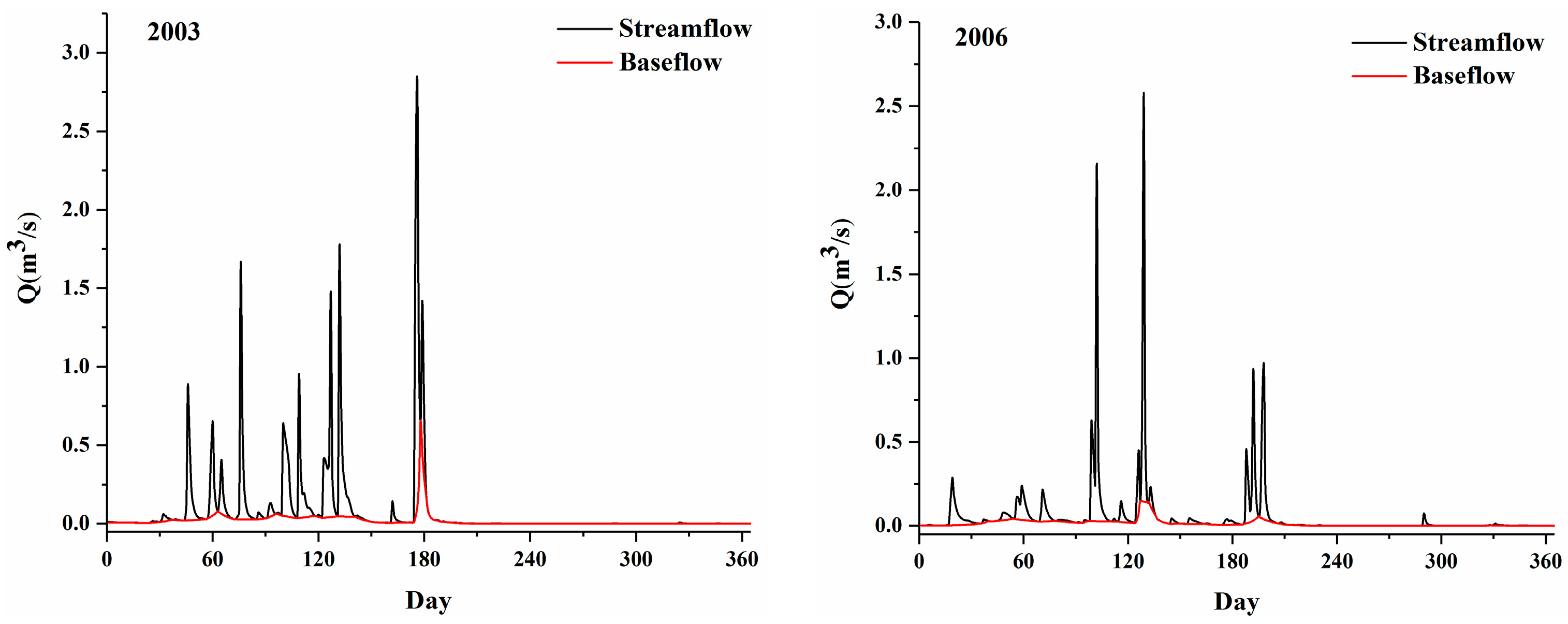
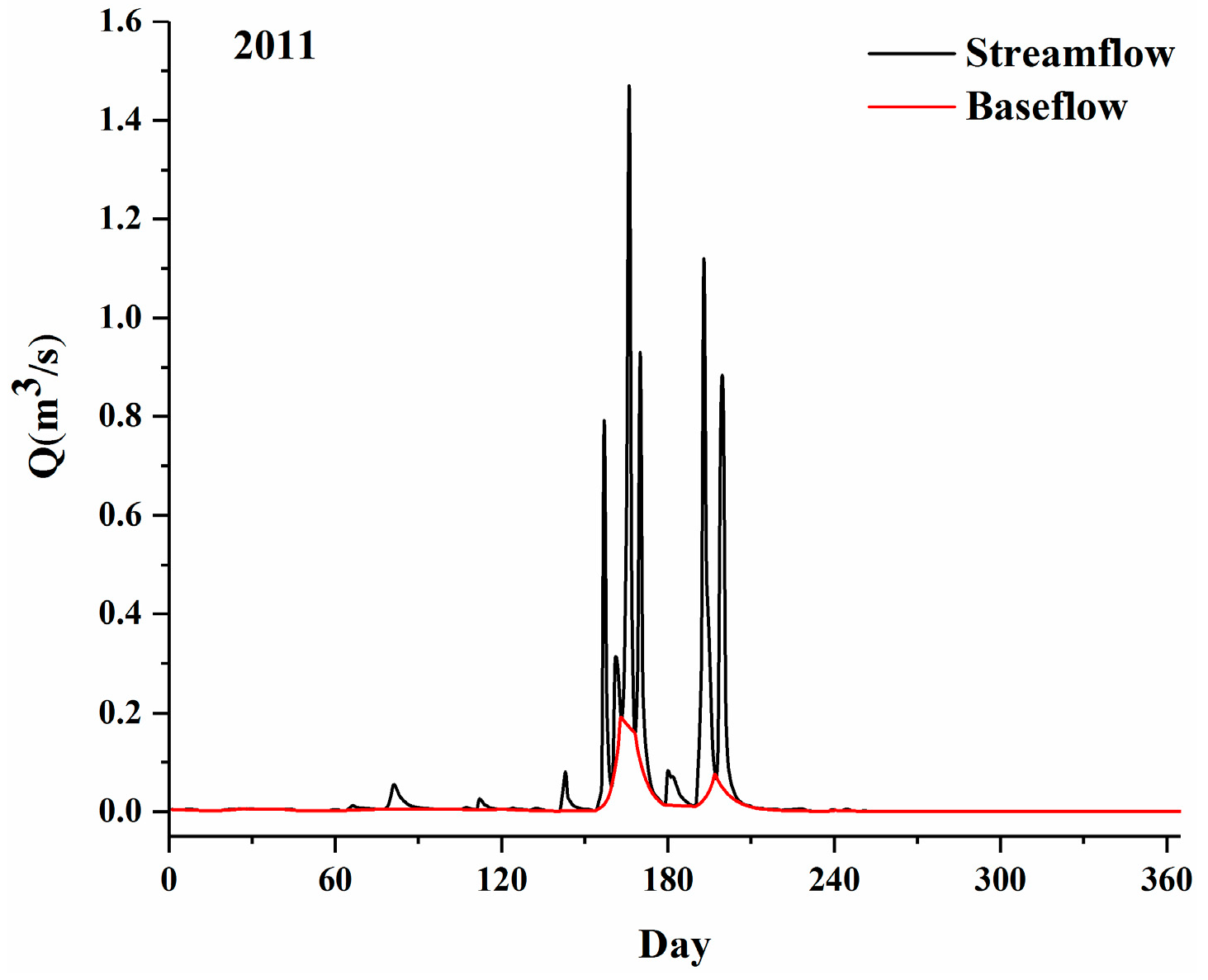
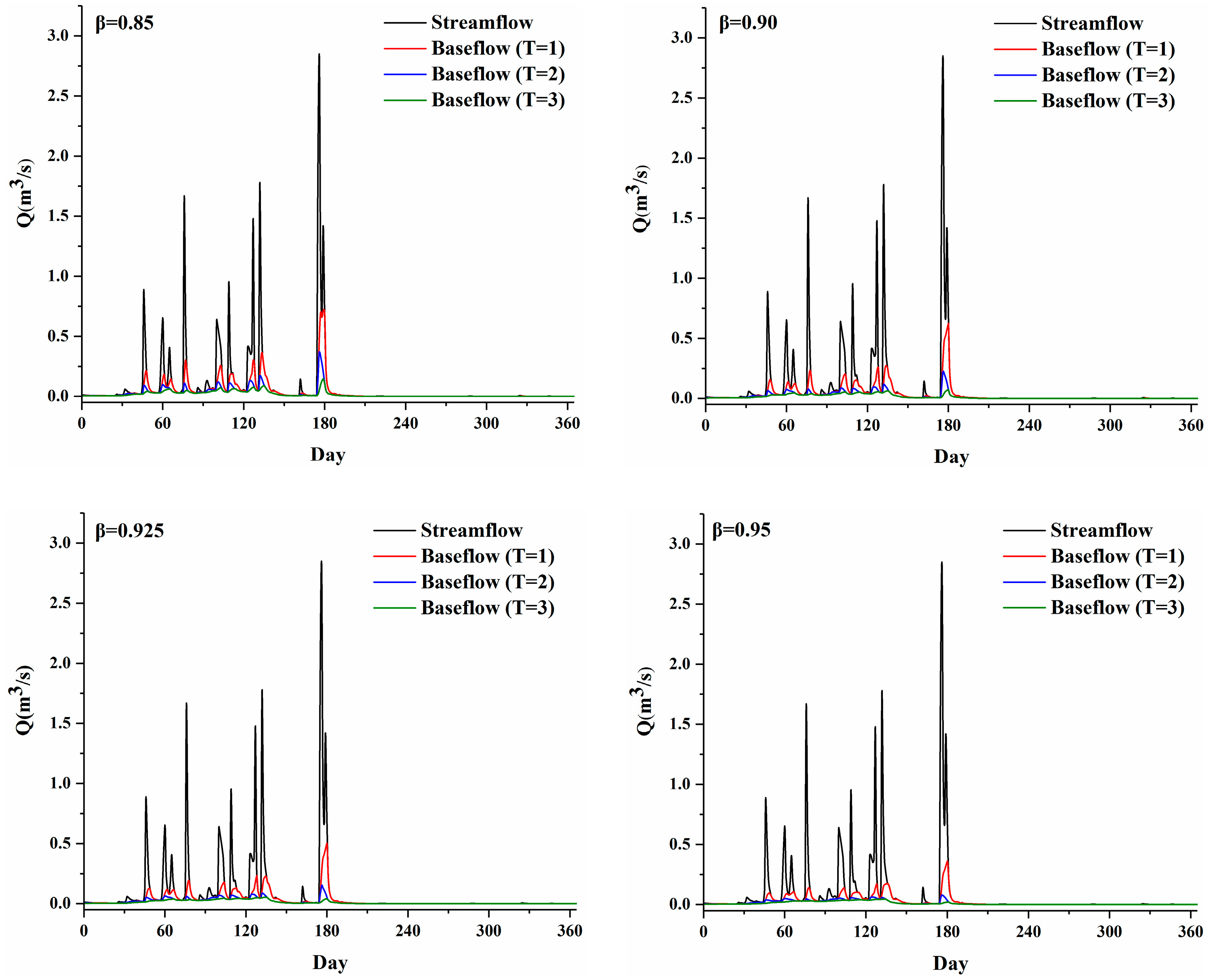
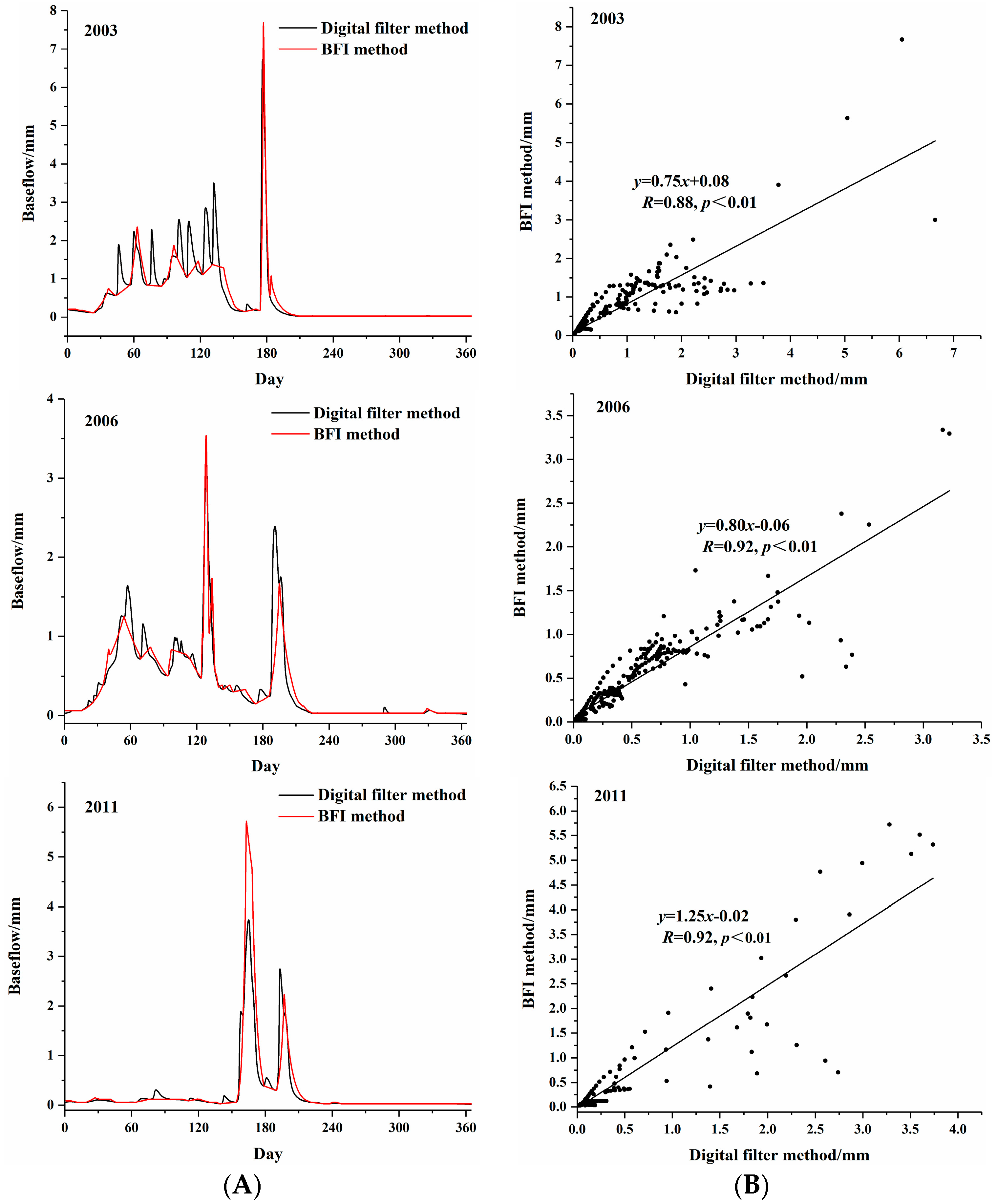
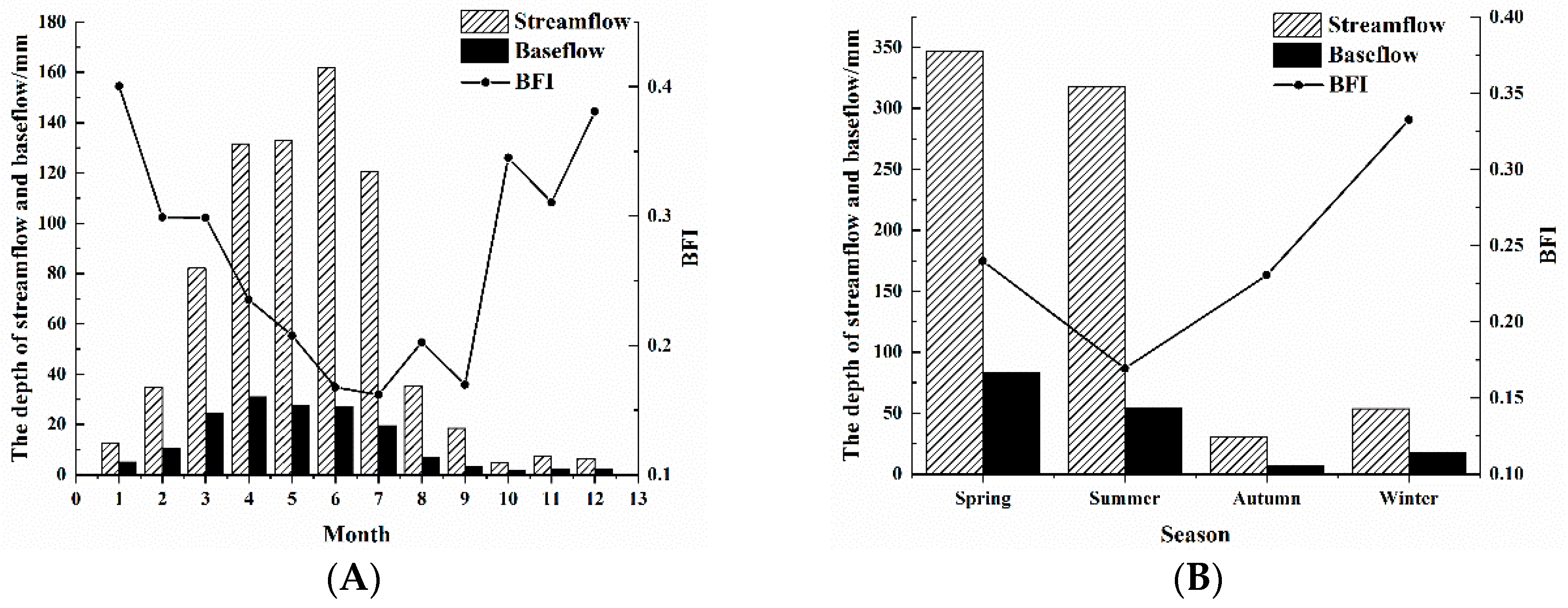

| Watershed | β | T | Optimal Parameter | Reference |
|---|---|---|---|---|
| 186 catchments (Southeastern Australia) | 0.9 ,0.925, 0.95 | 3 | β = 0.925, T = 3 | Nathan and Mcmahon, [11] |
| Laoguanhe watershed (China) | 0.85, 0.90, 0.925 | 1, 2, 3 | β = 0.85, T = 2 | Lin et al., [47] |
| New Hampshive watershed (USA) | 0.85, 0.925 | 1, 2, 3 | β = 0.85, T = 2 | Mau and Winter, [48] |
| Xiangxihe watershed (China) | 0.80, 0.90, 0.925, 0.95, 0.975 | 1, 2, 3 | β = 0.925, T = 3 | Cui et al., [49] |
| Juntanghu watershed (China) | 0.80, 0.85, 0.90, 0.925, 0.95 | 1, 2, 3 | β = 0.85, T = 3 | Zhang et al., [50] |
| Year | Annual Streamflow (mm) | Annual Baseflow (mm) | Maximum Monthly Baseflow (mm) | Minimum Monthly Baseflow (mm) | BFI Value |
|---|---|---|---|---|---|
| 2003 (wet) | 938.51 | 213.13 | 62.73 | 0.89 | 0.23 |
| 2006 (normal) | 630.75 | 154.70 | 48.69 | 0.89 | 0.25 |
| 2011(dry) | 387.70 | 101.49 | 60.41 | 0.89 | 0.26 |
| β | 0.85 | 0.90 | 0.925 | 0.95 | ||||||||
|---|---|---|---|---|---|---|---|---|---|---|---|---|
| T | 1 | 2 | 3 | 1 | 2 | 3 | 1 | 2 | 3 | 1 | 2 | 3 |
| Annual baseflow/mm | 439.87 | 245.63 | 171.74 | 381.55 | 199.51 | 142.18 | 341.76 | 174.33 | 126.64 | 291.96 | 147.56 | 109.76 |
| Maximum monthly baseflow/mm | 114.18 | 55.55 | 42.23 | 91.46 | 48.24 | 36.86 | 80.85 | 44.36 | 34.19 | 70.34 | 39.37 | 31.32 |
| Minimum monthly baseflow/mm | 0.89 | 0.83 | 0.83 | 0.89 | 0.78 | 0.78 | 0.89 | 0.75 | 0.75 | 0.89 | 0.69 | 0.69 |
| BFI | 0.47 | 0.26 | 0.18 | 0.40 | 0.21 | 0.15 | 0.36 | 0.19 | 0.14 | 0.31 | 0.16 | 0.12 |
| BFI attenuation rate/% | - | 44.68% | 30.77% | - | 47.50% | 28.57% | - | 47.22% | 26.32% | - | 48.39% | 25.00% |
| T | 1 | 2 | 3 | |||||||||
|---|---|---|---|---|---|---|---|---|---|---|---|---|
| β | 0.85 | 0.90 | 0.925 | 0.95 | 0.85 | 0.90 | 0.925 | 0.95 | 0.85 | 0.90 | 0.925 | 0.95 |
| Annual baseflow/mm | 439.87 | 381.55 | 341.76 | 291.96 | 245.63 | 199.51 | 174.33 | 147.56 | 171.74 | 142.18 | 126.64 | 109.76 |
| Maximum monthly baseflow/mm | 114.18 | 91.46 | 80.85 | 70.34 | 55.55 | 48.24 | 44.36 | 39.37 | 42.23 | 36.86 | 34.19 | 31.32 |
| Minimum monthly baseflow/mm | 0.89 | 0.89 | 0.89 | 0.89 | 0.83 | 0.78 | 0.75 | 0.69 | 0.83 | 0.78 | 0.75 | 0.69 |
| BFI | 0.47 | 0.40 | 0.36 | 0.31 | 0.26 | 0.21 | 0.19 | 0.16 | 0.18 | 0.15 | 0.14 | 0.12 |
| BFI attenuation rate/% | - | 14.89% | 10.00% | 13.89% | - | 19.23% | 9.52% | 15.79% | - | 16.67% | 6.67% | 14.29% |
| Digital Filter Method | BFI Method | ||||||||||||
|---|---|---|---|---|---|---|---|---|---|---|---|---|---|
| β | 0.85 | 0.90 | 0.925 | 0.95 | |||||||||
| T | 1 | 2 | 3 | 1 | 2 | 3 | 1 | 2 | 3 | 1 | 2 | 3 | |
| 2003 | 0.47 | 0.26 | 0.18 | 0.41 | 0.21 * | 0.15 | 0.36 | 0.19 | 0.14 | 0.31 | 0.16 | 0.12 | 0.23 |
| 2006 | 0.47 | 0.30 | 0.22 | 0.42 | 0.25 * | 0.18 | 0.38 | 0.22 | 0.16 | 0.33 | 0.19 | 0.14 | 0.25 |
| 2011 | 0.45 | 0.28 | 0.19 | 0.40 | 0.27 * | 0.15 | 0.37 | 0.19 | 0.12 | 0.32 | 0.16 | 0.10 | 0.26 |
| Catchment | Annual Precipitation | Annual Temperature | Soil Types | Optimal Parameters | Reference |
|---|---|---|---|---|---|
| The upper reaches of Heihe River watershed | 350 mm | <2 °C | Cultivated loessial soils, dark loessial soils | β = 0.95, T = 3 | Zhao et al. [28] |
| Xiangxihe watershed | 850–1400 mm | 16.6 °C | Yellow-brown earths, limestone soils, purplish soils | β = 0.925, T = 3 | Cui et al. [49] |
| Juntanghu River watershed | 200–300 mm | 26.6–37.8 °C | Castanozems brown pedocals, sierozems | β = 0.85, T = 3 | Zhang et al. [50] |
| Pengchongjian watershed | 1560 mm | 17.5 °C | Red soil | β = 0.90, T = 2 | This study |
© 2019 by the authors. Licensee MDPI, Basel, Switzerland. This article is an open access article distributed under the terms and conditions of the Creative Commons Attribution (CC BY) license (http://creativecommons.org/licenses/by/4.0/).
Share and Cite
Liu, Z.; Liu, S.; Ye, J.; Sheng, F.; You, K.; Xiong, X.; Lai, G. Application of a Digital Filter Method to Separate Baseflow in the Small Watershed of Pengchongjian in Southern China. Forests 2019, 10, 1065. https://doi.org/10.3390/f10121065
Liu Z, Liu S, Ye J, Sheng F, You K, Xiong X, Lai G. Application of a Digital Filter Method to Separate Baseflow in the Small Watershed of Pengchongjian in Southern China. Forests. 2019; 10(12):1065. https://doi.org/10.3390/f10121065
Chicago/Turabian StyleLiu, Zheng, Shiyu Liu, Jingping Ye, Fei Sheng, Kunming You, Xinhao Xiong, and Guilin Lai. 2019. "Application of a Digital Filter Method to Separate Baseflow in the Small Watershed of Pengchongjian in Southern China" Forests 10, no. 12: 1065. https://doi.org/10.3390/f10121065
APA StyleLiu, Z., Liu, S., Ye, J., Sheng, F., You, K., Xiong, X., & Lai, G. (2019). Application of a Digital Filter Method to Separate Baseflow in the Small Watershed of Pengchongjian in Southern China. Forests, 10(12), 1065. https://doi.org/10.3390/f10121065






